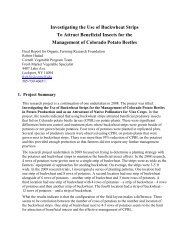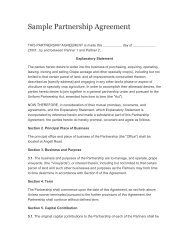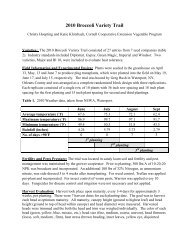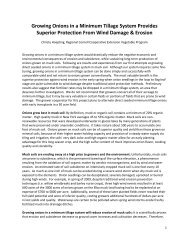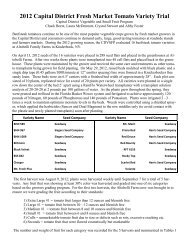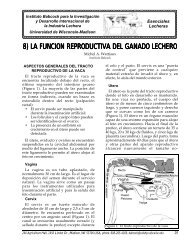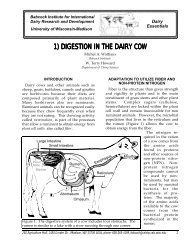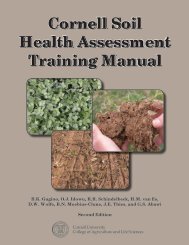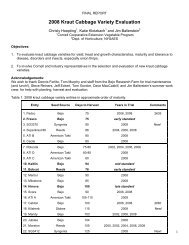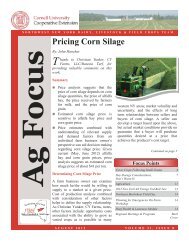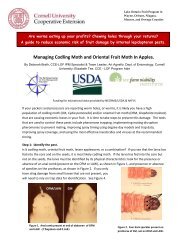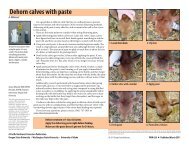9) heat detection, natural service and artificial insemination
9) heat detection, natural service and artificial insemination
9) heat detection, natural service and artificial insemination
Create successful ePaper yourself
Turn your PDF publications into a flip-book with our unique Google optimized e-Paper software.
Babcock Institute for InternationalDairy Research <strong>and</strong> DevelopmentUniversity of Wisconsin-MadisonDairyEssentials9) HEAT DETECTION, NATURAL SERVICE ANDARTIFICIAL INSEMINATIONMichel A. WattiauxBabcock InstituteINTRODUCTIONEfficiency of reproduction is one of themost critical aspects of a profitable herd.Economic losses resulting from delayedreproduction have multiple facets:• The lifetime milk production of thecows is reduced because peak milkproduction does not occur as often<strong>and</strong> the dry periods are extended;• The number of calves born per yeardecreases, giving fewer opportunitiesto cull cows with low milkproduction, <strong>and</strong> slowing the possiblegain in the genetic value of a herd;• The direct costs for treatment ofreproductive disorders, breeding <strong>and</strong>veterinary fees are increased.HEAT DETECTIONIn order to maximize productive life, acow must be bred within 80 to 90 daysafter calving. This will enable her toproduce a new calf every 12.5 to 12.8months. Longer calving intervals havedetrimental effects on lifetime milkproduction.Whether a producer uses <strong>artificial</strong><strong>insemination</strong> or <strong>natural</strong> <strong>service</strong>, <strong>heat</strong><strong>detection</strong> is a critical component of goodreproductive management on the farm.In either case, recording of cows in <strong>heat</strong><strong>and</strong> dates of <strong>service</strong>s is necessary topredict future <strong>heat</strong> or calving dates <strong>and</strong> tomanage the cows accordingly.What is <strong>heat</strong>?Heat is a period of acceptance for mating(sexual receptivity) that normally occursin non-pregnant, pubescent heifers <strong>and</strong>non-pregnant cows. This period ofreceptivity may last from six to 30 hours<strong>and</strong> occurs every 21 days on the average.However, the interval between two <strong>heat</strong>smay vary normally from 18 to 24 days.Signs of <strong>heat</strong>Detection of <strong>heat</strong> calls for acuteobservation. Most cows have a pattern ofbehavior that changes gradually from thebeginning to the end of a <strong>heat</strong>. The bestindicator that a cow is in <strong>heat</strong> is when shest<strong>and</strong>s <strong>and</strong> allows herself to be mountedby herdmates or a bull (Figure 1). A seriesof signs that may help to identify cowsthat need to be observed closely aresummarized in Table 1.Figure 1: A cow is in <strong>heat</strong> when shest<strong>and</strong>s immobile when mounted byanother cow or bull. A cow that mountsanother cow may or may not be in <strong>heat</strong>.240 Agriculture Hall, 1450 Linden Dr., Madison, WI 53706 USA, phone: 608-265-4169, babcock@calshp.cals.wisc.edu 33
Dairy Essentials: Reproduction <strong>and</strong> Genetic SelectionTable 1: Signs of estrus in dairy cowsSTANDING HEAT• St<strong>and</strong>s immobile when mounted.• Displays signs associated with early<strong>and</strong> late <strong>heat</strong>.EARLY AND LATE HEAT• Bellows like a bull.• Displays general signs of nervousness.• Rushes forward as if attacking; headto-headposition with another cow isfrequently seen.• Butts or pushes against the sides ofother cows.• Sniffs the vulva or urine of otheranimals; this is sometimes followedby inversion of the nostrils.• Cows circle each other, the one in<strong>heat</strong> attempting to rest her chin onthe back of the other; this may or maynot lead to mounting activity.• Pink <strong>and</strong> swollen vulva <strong>and</strong> clearmucous discharge are visible.INCIDENTAL SIGNS 1• Depressed appetite <strong>and</strong> milk yield.• Dirty animal (manure on flanks).• Tailhead has roughened appearancewith possible hair loss.1Non-specific signs whose occurrence depends on aparticular situation.Daily patterns in signs of <strong>heat</strong>The onset of <strong>heat</strong> activity follows adistinct pattern, with most activityoccurring in the late evening, through thenight, <strong>and</strong> in the early hours of themorning. Research shows that more than70% of mounting activity takes placebetween 7:00 at night <strong>and</strong> 7:00 in themorning (Figure 2). In order to detectmore than 90% of the <strong>heat</strong>s in a herd,cows should be observed carefully in theearly hours of the morning, the late hoursof the evening, <strong>and</strong> at four- to five-hourintervals during the day.Other factors influencing theexpression of <strong>heat</strong>Expression <strong>and</strong> <strong>detection</strong> of <strong>heat</strong> may bemore or less easy depending on a numberof factors. For example, the type ofhousing (stanchion barn, free stall,pasture, walking path along a fence, etc.)provides various degrees of ease for thecow to express signs of <strong>heat</strong> <strong>and</strong> for theproducers to detect cows in <strong>heat</strong>. In largerherds, more than one cow may come in<strong>heat</strong> at the same time. When this occurs,the chance of detecting cows in <strong>heat</strong>increases dramatically because mountingactivities also increase considerably. Forexample, two cows in <strong>heat</strong> at the sametime (sexually active group) cause atripling of mounting activity. In contrast,factors such as high temperature <strong>and</strong>humidity, wind, rain, snow, confinedspace, <strong>and</strong> conditions that may causeslipping, falling or hoof pain tend toinhibit the expression of <strong>heat</strong>.Percentage of total mounting activities2015105NightNight0 2:00 6:00 10:00 14:00 18:00 22:000:00 4:00 8:00 12:00 16:00 20:00 24:00Hours of the dayFigure 2: Most often, cows express signsof <strong>heat</strong> during the night.Absence of <strong>heat</strong>Heat may not be detected in cows for thefollowing reasons:• The cow is pregnant;• The cow has calved <strong>and</strong> the <strong>heat</strong>cycle has not yet resumed (silent<strong>heat</strong>);34 The Babcock Institute
9 - Heat, Service <strong>and</strong> Insemination• The cow is anestrus because of poornutrition, severe infection of thereproductive tract, or othercomplications after calving;• The cow has cystic ovarian disease;• The producer fails to detect a cowthat actually came in <strong>heat</strong>.ARTIFICIAL INSEMINATIONArtificial <strong>insemination</strong> is a technique bywhich semen is introduced <strong>artificial</strong>lyinto the body of the uterus at the time of<strong>heat</strong> in an attempt to cause pregnancy.The major advantages of <strong>artificial</strong><strong>insemination</strong> may be summarized asfollows:• It provides the opportunity to choosesires that are proven to transmitdesirable traits to the nextgeneration;• It eliminates the cost <strong>and</strong> danger ofmaintaining a bull on the farm;• It minimizes the risk of spreadingsexually transmitted diseases <strong>and</strong>genetic defects (e.g., mule foot);• It has cumulative beneficial effectsover the years.Use of <strong>artificial</strong> <strong>insemination</strong> makes itnecessary to develop a system to identifycows <strong>and</strong> record dates of <strong>heat</strong>s <strong>and</strong><strong>insemination</strong>s. Accurate recording isnecessary to develop good reproductivemanagement on the farm <strong>and</strong> it providesthe data for breeding associations to keepaccurate herd books.NATURAL SERVICEThe use of bulls for <strong>natural</strong> <strong>service</strong>remains widespread even in areas where<strong>artificial</strong> <strong>insemination</strong> has proven to bevery effective. Many farmers believe thatpregnancy rates are higher when a bull isused than when <strong>artificial</strong> <strong>insemination</strong> isused. However, when <strong>heat</strong> <strong>detection</strong> isaccurate <strong>and</strong> the <strong>insemination</strong> is properlyperformed, <strong>artificial</strong> <strong>insemination</strong> <strong>and</strong><strong>natural</strong> <strong>service</strong> give similar breedingsuccess.Continued use of <strong>natural</strong> <strong>service</strong> mayseem to be a paradox considering thegenetic advantages of <strong>artificial</strong><strong>insemination</strong>. However, there are threesituations when the use of <strong>natural</strong> <strong>service</strong>may be indicated:• When personnel are unwilling orinadequately trained to perform thetasks associated with <strong>heat</strong> <strong>detection</strong><strong>and</strong> the technique of <strong>artificial</strong><strong>insemination</strong>, leading to extremelypoor pregnancy rates;• When long term genetic gain is ofminor importance;• When local conditions do notprovide the infrastructure necessaryfor successful <strong>artificial</strong> <strong>insemination</strong>(access to semen, liquid nitrogenstorage tanks, telephones, etc.).Farmers with bulls on the farm shouldnever forget that bulls have caused manyfatal accidents. They represent a realdanger (especially when believed to besafe) <strong>and</strong> must be h<strong>and</strong>led firmly (with nosigns of fear) <strong>and</strong> with extreme caution.In addition, bulls may spread sexuallytransmitted diseases (vibriosis <strong>and</strong>trichomoniasis). Infected cows maybecome infertile for up to four months;or, if they conceive, early embryonic death(a form of abortion) may occur.TIMING OF SERVICE ORINSEMINATIONArtificial <strong>insemination</strong> or <strong>natural</strong><strong>service</strong> lead to a pregnancy only if thespermatozoa are "at the right place at theright time." The egg is released from theovary about 10 to 14 hours after the end of<strong>heat</strong> <strong>and</strong> can only survive unfertilized forsix to 12 hours. In contrast, thespermatozoa may live up to 24 hours inthe reproductive tract of a cow. Acommon recommendation for the besttiming of <strong>artificial</strong> <strong>insemination</strong> is the"morning-evening" rule: cows observedUniversity of Wisconsin-Madison 35
Dairy Essentials: Reproduction <strong>and</strong> Genetic SelectionWhen to Service a Cow in HeatComing into <strong>heat</strong>8 hours (0-24 h)St<strong>and</strong>ing <strong>heat</strong>16 hours (3-30 h)Going off <strong>heat</strong>8 hours (2-24 h)0 6 12 18 24 HoursArtificial Insemination:Too Early Good Best GoodToo LateTooNatural Service:Early Best Too LateFigure 3: Timing of <strong>insemination</strong> or <strong>natural</strong> <strong>service</strong> for cows in <strong>heat</strong>in <strong>heat</strong> in the morning are inseminatedthe same evening, <strong>and</strong> cows ob-served in<strong>heat</strong> in the afternoon are inseminated thenext morning.In the case of <strong>natural</strong> <strong>service</strong>, the cow<strong>and</strong> the bull may be allowed to matestarting a few hours after the cow acceptsmounting until the cow refuses to bemounted (Figure 3).CAUSES OF LOWCONCEPTION RATESMore than 90% of the cows in a herdshould require fewer than three <strong>service</strong>sto conceive. Possible causes of lowconception rates (less than 50%) may fallinto different categories:1) Problems related to <strong>heat</strong> <strong>detection</strong>:• Not servicing a cow that is in <strong>heat</strong>;• Servicing a cow that is not in <strong>heat</strong>;• Improper timing of <strong>service</strong>;• Misidentification of cows leading toerrors in records;2) Problems related to <strong>natural</strong> <strong>service</strong>or <strong>artificial</strong> <strong>insemination</strong>:• A bull with a low fertility;• Improper <strong>insemination</strong> techniques;3) Cow factors:• Infection of the reproductive tract;• Hormonal disorders;• Obstructed oviducts;• Anatomical defects;• Early embryonic death (cow becomespregnant, but the pregnancy is notmaintained);4) Problems related to nutrition (seeDairy Essentials: “Reproduction <strong>and</strong>Nutrition”).36 The Babcock Institute



